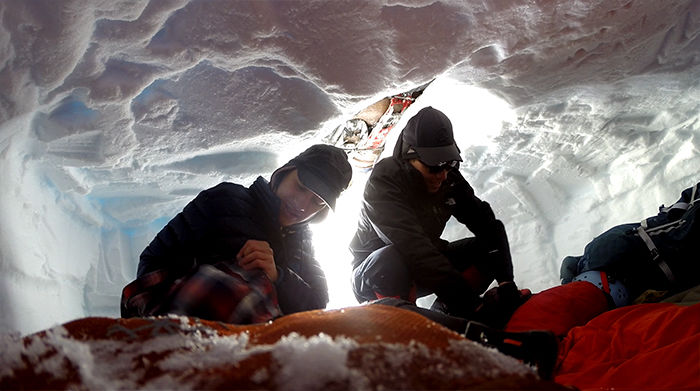Misery and marvel on Rainier
May 10, 2017
Toes tingling with cold, I awake two meters beneath the surface of the snow. The first thought enters my mind instantly. “Well, I’m alive.”
The ramshackle roof of our snow cave has not collapsed, though it consists mainly of flimsy trekking poles, bowing beneath the weight of a snow-covered tarp. The whole framework sags ominously toward the floor on which we sleep.
The afternoon before, our eight-person Outdoor Recreation Center team digs two icy shelters near Mount Rainier’s Nisqually Glacier. White-out conditions force us to abandon our goal of Panorama Point as we settle for a more modest elevation of 6,300 feet.
Across the glacier, the mountain rises another 8,000 feet, though we cannot see it yet. For now, we can see just far enough to construct the two caves and small “kitchen” that will be our home for the night.
I hack away at the larger cave for several hours, excavating hundreds of pounds of snow and thick ice blocks. Jonathan Stahl, a skilled outdoorsman and one of the ORC guides, digs with me for awhile.
Scoop, heave, scoop, heave.
Stahl glances at me with a smile.
“How do you not do something for the Evergreen?” he says between shovelfuls, wondering how I could possibly leave the experience unwritten. Apparently I couldn’t.
Once we clear a 10-by-10-foot space, large enough for four people and their bulky packs, we cover the cave. The work kept me warm, but once I stop digging I realize the snowfall has drenched me.
We huddle in the kitchen, over which we have erected a tarp in teepee fashion, to melt snow for the next day’s drinking water. We stand around the boiling pots for two hours, trying to absorb every bit of heat from the meager flame of a WhisperLite stove – a single flame against a mountain of ice.
I have read descriptions of the harsh alpine environment, but you can’t feel the word frostbite. The Rainier night does not approach the lethal temperatures of higher mountains, but still I did not expect to be so cold.
Stahl and Ben Phaneuf, the other ORC guide, stand across the kitchen’s counter from me. As they handle the melting operation, they eventually realize we do not have enough fuel for the second night.
Freezing, still damp to the skin, and running low on our sole heat source.
“You’re getting a true mountaineering experience,” Phaneuf says.
But relatively, Stahl adds, “this is comfortable.”
I force myself, over and over, to repeat Stahl’s downplaying in my head. We talk and joke as we shiver, and the cold is just bearable. And then we crawl into our nice, warm snow caves.
Stahl says these shelters stay always at a tolerable 32 degrees Fahrenheit, that they are inescapably on the cusp of freeze, but never below. I do not know what law of physics makes this so, but a bottle of water I leave outside my sleeping bag overnight is still a bottle of water when I awake.

An ORC group takes in the view from Mount Rainier’s Panorama Point over spring break.
I crawl out of the cave in the morning to dazzling sun. The storm has receded and hangs miles off on distant Cascade ranges. Rainier looms like an ice fortress, and when I see it I know immediately that this is what justifies the miserable moments. I am alive.
We spend the next few hours learning how to navigate a mountain. Before we descend we climb to Panorama Point, our original first-day goal, to catch its namesake view, and then we trudge back down.
The shadows from the snow-clad evergreens grow longer as we near Paradise, and I feel the night chill begin to reassert itself.
In a day, Rainier both welcomes and spurns. But as we drive away, toward Pullman, I look back at the peak and understand that the two augment each other. The mind-bending vistas are more stunning after a blizzard opens to reveal them, the sunlight warmer after a frigid night.
It’s easy to take sensations for granted in daily life, but on a mountain, raw experience rules. On a mountain, even in sleeplessness, I am awake. In exhaustion, I am alert. In wind and snow, in sun and ice, I am alive.









